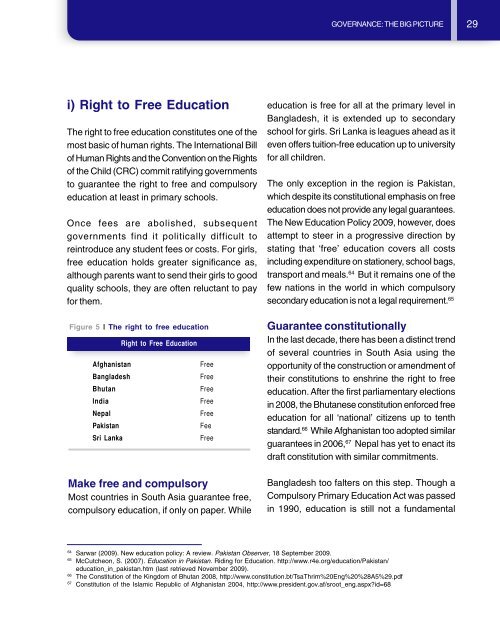Cover(final) - United Nations Girls' Education Initiative
Cover(final) - United Nations Girls' Education Initiative
Cover(final) - United Nations Girls' Education Initiative
Create successful ePaper yourself
Turn your PDF publications into a flip-book with our unique Google optimized e-Paper software.
GOVERNANCE: THE BIG PICTURE 29<br />
i) Right to Free <strong>Education</strong><br />
The right to free education constitutes one of the<br />
most basic of human rights. The International Bill<br />
of Human Rights and the Convention on the Rights<br />
of the Child (CRC) commit ratifying governments<br />
to guarantee the right to free and compulsory<br />
education at least in primary schools.<br />
Once fees are abolished, subsequent<br />
governments find it politically difficult to<br />
reintroduce any student fees or costs. For girls,<br />
free education holds greater significance as,<br />
although parents want to send their girls to good<br />
quality schools, they are often reluctant to pay<br />
for them.<br />
Figure 5 | The right to free education<br />
Afghanistan<br />
Bangladesh<br />
Bhutan<br />
India<br />
Nepal<br />
Pakistan<br />
Sri Lanka<br />
Right to Free <strong>Education</strong><br />
Free<br />
Free<br />
Free<br />
Free<br />
Free<br />
Fee<br />
Free<br />
education is free for all at the primary level in<br />
Bangladesh, it is extended up to secondary<br />
school for girls. Sri Lanka is leagues ahead as it<br />
even offers tuition-free education up to university<br />
for all children.<br />
The only exception in the region is Pakistan,<br />
which despite its constitutional emphasis on free<br />
education does not provide any legal guarantees.<br />
The New <strong>Education</strong> Policy 2009, however, does<br />
attempt to steer in a progressive direction by<br />
stating that ‘free’ education covers all costs<br />
including expenditure on stationery, school bags,<br />
transport and meals. 64 But it remains one of the<br />
few nations in the world in which compulsory<br />
secondary education is not a legal requirement. 65<br />
Guarantee constitutionally<br />
In the last decade, there has been a distinct trend<br />
of several countries in South Asia using the<br />
opportunity of the construction or amendment of<br />
their constitutions to enshrine the right to free<br />
education. After the first parliamentary elections<br />
in 2008, the Bhutanese constitution enforced free<br />
education for all ‘national’ citizens up to tenth<br />
standard. 66 While Afghanistan too adopted similar<br />
guarantees in 2006, 67 Nepal has yet to enact its<br />
draft constitution with similar commitments.<br />
Make free and compulsory<br />
Most countries in South Asia guarantee free,<br />
compulsory education, if only on paper. While<br />
Bangladesh too falters on this step. Though a<br />
Compulsory Primary <strong>Education</strong> Act was passed<br />
in 1990, education is still not a fundamental<br />
64<br />
Sarwar (2009). New education policy: A review. Pakistan Observer, 18 September 2009.<br />
65<br />
McCutcheon, S. (2007). <strong>Education</strong> in Pakistan. Riding for <strong>Education</strong>. http://www.r4e.org/education/Pakistan/<br />
education_in_pakistan.htm (last retrieved November 2009).<br />
66<br />
The Constitution of the Kingdom of Bhutan 2008, http://www.constitution.bt/TsaThrim%20Eng%20%28A5%29.pdf<br />
67<br />
Constitution of the Islamic Republic of Afghanistan 2004, http://www.president.gov.af/sroot_eng.aspx?id=68

















